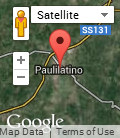
E-learning
More information about the history of the site
Santa Cristina Archaelogical area is located in the center – western part of the Sardinian island, within the municipal territory of Paulilatino (Oristano), on the Abbasanta upland; it is one of the most well – know and characteristic sacred sites of Sardinian protohistory. Santa Cristina was an important area during various periods, starting with the Bronze Age, through the Middle Ages and up to modern times.
The Santa Cristina archaeological area is divided in two parts, separated by the rural church devoted to Saint Cristina and its adjacent traditional “cumbessias” (shelters of pilgrims).
The well temple, dated to the Early Iron Age Period ca. 900BC, was constructed from unhewn large basalt blocks arranged in several courses along the outer and internal perimeters and perfectly cut stones forming the stairs and the underground components of the structure (the tholos and the roof of the underground passage – the isidomum technique).
The well consists from three parts: a. the Atrium,a rectangular space from which one can access the sacred area and the well, b. the Staircase, perhaps the most characteristic part of the temple. It consists of 25 steps developing into a trapezoidal form and an overturned stair roofing and c. the Tholos, proceeding down on the staircase one enters into the well chamber. It is a conical and hypogeal tower, 6.90 meters high (cut into the bedrock). The bottom of the well is a tank cut out of the basaltic rock having in the middle a circular settling tray, 0.50 meters deep.
Over the chamber an internal circular space was dedicated probably to rituals related to water worship. A bench seat was along the internal wall of the structure. It is still unclear if the entire area was roofed or not.
The perfect smoothness and precise cut of the stones makes the Santa Cristina sacred well an excellent example of the technical perfection achieved by the Nuragic artisans.
Reference
CONTU E. 1997. La Sardegna Preistorica e nuragica, Sassari, Chiarella.
DEPALMAS A., MELIS R.T. 2010. The Nuragic people: their settlements, economic activities and use of the land, Sardinia, Italy, in MARTINI P.I., CHESWORTH W. 2010, Landscapes and Societies, online book, pp.167.186.
LILLIU G. 2003. La civiltà dei sardi dal Paleolitico all’età dei nuraghi, Eri, Nuoro.
MORAVETTI A. 2005. Il santuario nuragico di Santa Cristina. Sardegna Archeologica. Guide e Itinerari, n.32, Carlo Delfino Editore, Sassari.
